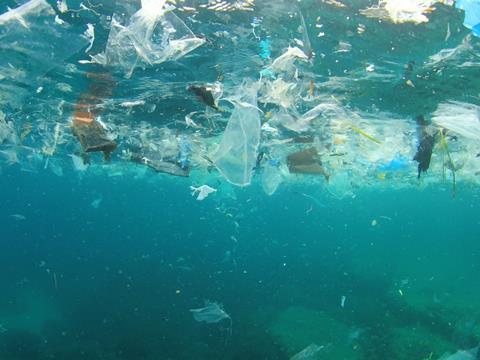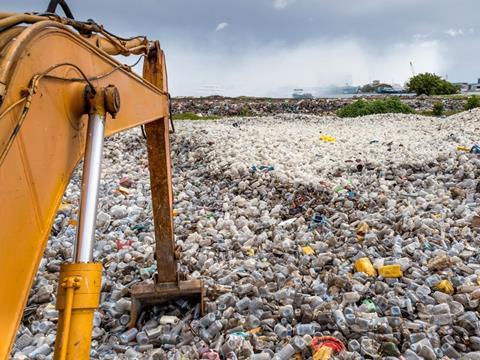Shardul Agrawala, Head of the Environment and Economic Integration Division of the OECD Environment Directorate, discusses the findings of the OECD’s Global Plastic Outlook report and different possible ways to avert the predicted tripling of plastic waste by 2060 with Elisabeth Skoda.

High-profile efforts have been made to reduce plastic waste. Despite that, the Global Plastics Outlook finds that, in the absence of new policies, by 2060 the world will be producing and consuming almost three times as much plastics as it is today. This is projected to result in the near-tripling of waste plastic generation, a doubling in plastic leakage to the environment – from 22 million tonnes (Mt) in 2019 to 44 Mt in 2060 and a tripling in the build-up of plastics accumulating in rivers and the ocean (from 140 Mt in 2019 to 493 Mt in 2060). Beyond leakage, the management of end-of-life plastics also contributes to greenhouse gas emissions and bears implications for human health due to the persistence of harmful practices such as open pit burning. The outlook here is equally grim: GHG emissions from plastics production and end of life are projected to double to 4.3 gigatonnes of carbon dioxide equivalents of GHG emissions in 2060.
“In our review of policies around the world, we find that a relatively large number of countries have enacted legislation to ban or tax single-use plastics, aiming to reduce their consumption and consequently their leakage to the environment. However, existing bans and taxes tend to focus on a few single-use applications such as shopping bags, straws and polystyrene food packaging. While these interventions may effectively reduce littering, their narrow focus on small product streams means that they have a limited impact on overall plastics consumption and waste generation,” explains Mr Agrawala.
“In this context, our Global Plastics Outlook calls for greater use of innovative economic instruments and binding targets to foster the design of more circular products, restrain the use of plastics, ensure a business case for recycling, and replace the use of virgin plastics with recycled materials.”
He explains that as a leading institution in environmental policy analysis and advice, the OECD provides a unique forum for policymakers to discuss policy options, strategies and challenges, share best practices in environmental policy and compare progress, including in the area of plastic pollution.
“More specifically, the economic and policy analysis contained in the Global Plastics Outlook publications can serve as a point of reference to support decision-makers in understanding the scale of the challenges posed by plastics, assessing which policies can support a more sustainable and circular management of plastic materials, and ultimately scaling up domestic as well as international action to reduce plastic pollution.”
Focus on packaging
While the report covers all plastics, not just those used in packaging, nearly two-thirds of plastic waste comes from plastics with lifetimes of under five years: packaging, low-cost consumer goods, clothing and textiles.
“The report states that packaging currently constitutes 40% of annual waste generation. Waste from packaging is on track to continue to increase, reaching 380 Mt per year in 2060 (from 142 Mt in 2019), although its share in overall waste is projected to slightly decrease to 37% as waste generation increases at a faster rate for other applications,” says Mr Agrawala.
While poorly managed plastic waste generates serious environmental impacts, it is also clear that plastics deliver significant benefits to society. The challenge is to retain those benefits without incurring the environmental costs, or at least minimizing them. The Global Plastic Outlook charts a way how this can be achieved.
“Eliminating unnecessary plastics, promoting longer lifespans and switching to reuse systems could drastically reduce consumption, waste generation and the related environmental impacts. For packaging that does become waste, it is crucial to ensure that it is recycled and used to replace virgin materials in new production processes. The eco-design of packaging and products plays a crucial role to ensure that plastics put into the economy, are sustainable, safe and contribute to the circular economy. Eco-design should generally aim to avoid hazardous materials, facilitate reusability/recyclability and prefer recycled content.”

Evidence from selected OECD countries shows that instruments such as recycled content targets, Extended Producer Responsibility (EPR) schemes for both packaging and durables (including with advanced fee modulation), landfill and incineration taxes, deposit-refund schemes and Pay-as-You-Throw systems can be effective levers to mandate eco-design criteria such as minimum recycled content requirements, enhance waste sorting done by households and discourage landfilling in favour of recycling. To deliver impact, they need to be implemented more systematically and across a much larger number of countries than is currently the case.
“In less advanced countries, efforts also need to focus on improving basic waste management services to reduce the prevalence of harmful end-of-life treatment options and close leakage pathways,” Mr Agrawala adds.
A joined-up approach
A whole life-cycle approach is required to effectively reduce the negative externalities generated by plastics and plastic waste, combining policy interventions downstream of the value chain, such as improved waste management in non-OECD countries and enhanced recycling globally, as well as upstream, including through product design.
To achieve drastic reductions in plastics use, waste generation and the related environmental impacts, urgent and coordinated action across countries is essential, alongside international support to accelerate improvements in waste management systems and practices in least developed countries.
“Our modelling projections find that the global implementation of ambitious circular policies to curb plastic leakage to the environment can reduce plastics use and waste by a third below business-as-usual projections and reduce mismanaged plastic waste to almost zero by 2060, at an annual cost of less than 1% of global GDP. However, the bulk of the costs will be borne by non-OECD countries, as substantial investments must be made to ensure that everyone has access to adequate waste collection and disposal services. This highlights the need for supportive policies and international financial support to bridge the financing gap and to ensure the situation for vulnerable households is not exacerbated,” Mr Agrawala says.
Considering the alternatives
There is no silver bullet to solve the current plastic crisis and solutions will need to be deployed all along the plastics lifecycle to effectively reduce the environmental impacts generated by plastics and plastic waste.

“As previously discussed, abandoning unnecessary single-use applications in favour of reuse of longer lifespans is one of the priorities for action upstream in the value chain to drastically reduce waste generation from short-lived applications. Furthermore, switching to alternative materials in production can minimize lifecycle impacts in some cases as long as their environmental footprint is not larger than plastics, and most importantly, the switch to alternative materials per se does not necessarily change the way the product or packaging is used nor extend its lifespan. Hence, while material choice considerations at the design stage are important, they should also be informed by waste prevention objectives such as the elimination of unnecessary plastics and the achievement of higher reuse rates.”
Plastic recycling also has an important role to play in lowering plastics’ environmental footprint, as it diverts material from more harmful waste management practices, and the availability of recycled plastics can help lower the demand for virgin plastics.
“Stronger policy intervention is required to boost markets for recycled plastics, which still only account for 6% of total feedstock. Policies to ‘push’ supply, for example through Extended Producer Responsibility schemes or taxes on non-recycled plastic waste, ‘pull’ demand for recycled plastic (e.g. recycled content targets) and enhance waste sorting at source are key to improve the quantity and quality of recycled plastics going into new production processes, and to strengthen the business case for plastic recycling,” Mr Agrawala explains.
“We need a three-pronged approach to curb plastic demand, increase product lifespans, and improve waste management and recycling.”
Focus on innovation
What all solutions have in common is the important role played by innovation. Along the entire plastics value chain, innovation can help to reduce the environmental impacts of plastics in many ways.
“At the level of product design and manufacturing processes, innovation can reduce the amount of feedstock required, as well as facilitate reuse and recycling. Innovation in recycling technologies can enhance the overall circularity of the economy. For instance, plastic-to-plastic chemical recycling offers the potential to recycle waste that cannot be processed with mechanical recycling, although it remains an emerging technology that still faces significant challenges. The deployment of new business models can also substantially contribute to waste prevention, for instance through new delivery models that employ reusable rather than single-use packaging.”
In conclusion, Mr Agrawala highlights the fact that in recent years, a confluence of seminal research and high-profile media focus on plastics in the environment has put plastics at the centre of public preoccupation with the environment.
“This surge in public attention has also coincided with a proliferation of local, national and international policy responses in this policy area, including the historic Resolution 5/14 ‘End plastic pollution: Towards an international legally binding instrument’ adopted by the United Nations Environmental Assembly in February 2022 to convene an intergovernmental negotiation committee, with the ambition of completing its work by the end of 2024, to develop an international legally binding instrument on plastic pollution. This is clearly a seminal development and I hope will provide the global impetus we need. At the same time, we also need to scale up innovation – both technological and process innovation – to reduce the environmental impacts of plastics throughout the plastics life cycle. And last but not least, to better influence consumer and household behaviour which is critical to turning around this spiralling of plastic waste.”












No comments yet